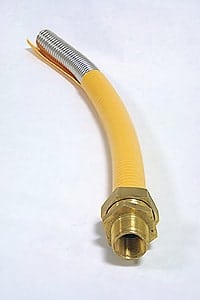CSST Gas Line Bonding : Gas Line Bonding For Safety

What is CSST Gas Line Bonding?
At the forefront of new residential construction and renovation concerns and in some industrial structure is the often-underrated area of gas line installation and maintenance as a safe and durable means to supply natural gas to a structure. A specific aspect gaining much-needed attention in recent years is the bonding of natural gas lines needed to ensure safe electrical service, particularly those built with Corrugated Stainless Steel Tubing (CSST). This article will overview the importance of gas line bonding, focusing on bonding CSST, and how this seemingly technical detail can significantly affect the safety of homes (note: while corrugated stainless steel tubing is also used as a flexible gas line in industrial structures, it is most common in residences, thus that will be the focus of this post).
Understanding the Importance of Gas Line Bonding
To understand the urgency behind natural gas line bonding, first let’s talk about the nature and function of CSST. Corrugated Stainless Steel Tubing (CSST), as the name suggests, is a flexible gas line used to supply natural gas within homes. Its flexibility and ease of installation have made it a popular choice in modern residential construction when installing a new gas line ur upgrading older lines. However, its unique properties also leave it more vulnerable to a lightning strike than traditional rigid pipes. When lightning strikes a home, it seeks out any conductive paths, and poorly bonded CSST can carry a charge, potentially leading to perforation and CSST gas lines could leak gas.
The Misunderstood Complexity of CSST
Many homeowners may question why gas line bonding was not done during initial installation. The answer lies in the evolving nature of industry standards. CSST entered the U.S. market in the 1990s, but it wasn’t until much later, in response to incidents and reports of damage from lightning strikes, that bonding requirements became more stringent. The National Electrical Code (NEC) now mandates that CSST be directly bonded to the home’s electrical service grounding electrode system for safety.
Safety First – Revisiting Home Gas Line Systems
It is crucial for homeowners to inspect their gas line systems, particularly if they were installed or modified after 1990. Understanding the type of gas piping systems in your home – whether black iron/galvanized pipe, copper tubing, flexible appliance connectors, or CSST gas piping, everywhere from the basement to your attic spaces – should be a starting point in your safety assessment. Inspections should confirm that your gas piping system is properly bonded and adheres to current safety standards in your electrical service, especially if CSST is present. This is best done by a licensed electrician to ensure that all standards are met and safety concerns are addressed.
Recognizing Some Red Flags in Gas Line Safety
Certain indicators can hint at gas line bonding deficiencies or the need for a safety reassessment. For instance, if you experience electrical problems, these could be signs of undetected arcing due to ungrounded CSST gas piping systems. Other common issues include shock waves and strange noises during thunderstorms, which may point to compromised gas line integrity.
The Importance of Professional Assessment
Gas line bonding, and really any work related to your gas piping system, is a job best suited for professional electricians following proper installation instructions. These experts can evaluate the adequacy of CSST bonding, ensuring it complies with CSST manufacturer’s instructions and recommendations and NEC guidelines. Investing in such assessments can prevent catastrophic events and provide peace of mind and uninterrupted safe electric service for homeowners.
ARC Electric and Our Commitment to Gas Line Safety
In the Apex, Cary, Holly Springs, and Raleigh areas, ARC Electric are the experts at natural gas line safety with the experience and expertise to properly bond CSST. With a proactive approach to proper CSST bonding, we offer comprehensive services from a licensed electrician that safeguard homes from the potential hazards associated with lightning and other electrical surges. We encourage residents to reach out for consultations and professional assessments.
Safeguarding Homes and Families
Your home is more than just a living space – it is an investment and a legacy. For this reason, taking the extra steps to ensure its safety is not just a good idea, but a responsibility. In the context of gas piping systems and in consideration of Corrugated Stainless Steel Tubing (CSST), proper bonding is neither a formality nor an optional extra – ensuring CSST is properly bonded to the homes electrical service grounding electrode system is a necessary component of your home’s defense against potential disaster.
By staying informed and engaging with electrical service professionals who understand the ins and outs of this safety necessity, homeowners can protect their most precious asset against the unforeseen, ensuring that their homes remain not just beautiful and functional but, above all, safe.
